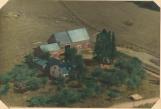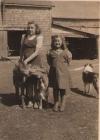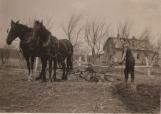1
Sylvia Ross' Childhood MemoriesSylvia was born in 1923 and has clear memories of her childhood growing up on a farm and her teaching days as a young woman. She is still active in the community, driving herself to functions and to Tatamagouche. Sylvia's great-grandparents were Langilles from Brule Point. The large family bought a farm at Millbrook, about seven miles outside Tatamagouche and Sylvia was born and raised there.
2
The Millbrook farm from the air19th century
Millbrook, Nova Scotia Canada
 Credits:
Credits:Sylvia Ross nee Langille
Pam Gunn
3
Sylvia's father had a large apple orchard with 25 varieties of apples, many of which he grafted himself. She strongly remembers the smell of apples stored in the basement, and having a large apple for lunch.He also hired men to work the farm woodlot. Some of these workers stayed in a log cabin on the lot, and some lived in another part of the farmhouse. Sometimes Sylvia went to the log cabin for supper, and recalls the pancakes made over the fire.
She remembers that her mother cut up and remade coats from old ones given to her. While Sylvia hated some of the things she had to wear, some were sent from friends living in Boston which were more popular. Flour sacks were washed and bleached and made into curtains, sheets, underwear - even lining a swimsuit Sylvia made.
4
Growing up on the Millbrook farm20th century
Millbrook, Nova Scotia Canada
 Credits:
Credits:Sylvia Ross
Pam Gunn
5
There were few excitements at Christmas although they were still greatly enjoyed. The children would receive an orange and plenty of peanuts and Sylvia reacalls that the shells would be everywhere! There was also ribbon candy, homemade fudge and maybe a few toys. She remembers her mother taking the centre from a worn oilcloth tablecloth, and making stuffed animals for Christmas. Once, her father gave her $5.00 to spend for presents. So Sylvia went to the village to get gifts for her family, getting a lift in one of the cream trucks that traveled between the farms and Tatamagouche. When she got home, her younger sister came to watch Sylvia wrap the presents and then she slipped away to tell their Mother what Sylvia had bought her (slippers which cost 33 cents)!Molasses was the main sweetener used when Sylvia was young. She remembers eating butter and molasses sandwiches. Newspaper was often used to wrap sandwiches, and only poor families had sandwiches without butter Baked bean sandwiches were favorites. Homemade remedies for illnesses were also common and a visit to the doctor a rare thing. There were times.when doctors could not make it to a birth, so any nurse married to a local man was called in. Reports were that the kitchen table was used for operations - especially in the case of appendicitis! X-rays were developed during this time and many had fun seeing the outline of their feet when trying on new shoes. Sulphur drugs also came into use and DDT was very popular as it did wonders for body lice when applied as dust!
6
Sylvia Ross early memories - church, school and teaching20th century
Middleton, Nova Scotia, Canada
 Credits:
Credits:Sylvia Ross
7
Sylvia's mother was determined that her daughter would be well educated. Sylvia attended local schools, after which she did a quick course in teaching. Teachers were hard to attract as money was better in the munitions factories at the time. She took night and summer school and earned money as a waitress on the side. Eventually Sylvia received her GC6 certificate. She went on to teach for twenty years at the Tatamagouche Regional High School and later the Elementary School in Tatamagouche.8
Plowing on the Millbrook farm20th century
Mill Brook, Nova Scotia, Canada
 Credits:
Credits:Sylvia Ross
Pam Gunn